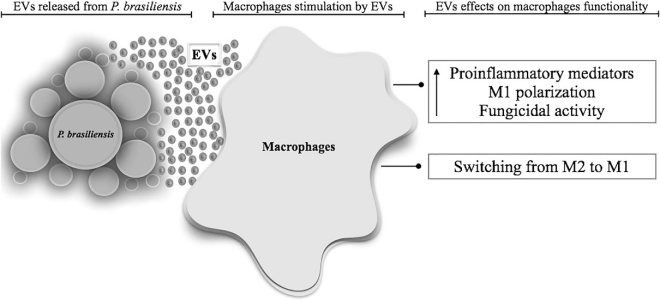Paracoccidioides-derived Exosome Research and Application
Paracoccidioides is a type of environmental fungus widely distributed in the soil, capable of infecting both humans and animals. In populations with normal immune systems, these infections generally do not lead to serious diseases; however, in immunocompromised individuals, such as those with HIV, undergoing chemotherapy, or receiving immunosuppressive treatments, paracoccidioidomycosis can cause severe health issues, even being fatal. Treating this infection usually requires antifungal medications, but due to side effects and resistance issues associated with these drugs, treatment often poses challenges. As a provider of exosome technology, Creative Biolabs encourages clients to research exosomes released by Paracoccidioides, which can not only advance scientific research in this field but also help in developing new treatment methods.
Two Types of Paracoccidioides
Paracoccidioides brasiliensis and Paracoccidioides lutzii, both belonging to the genus Paracoccidioides, are the primary pathogens causing paracoccidioidomycosis in humans. Although these two fungi belong to the same genus, they differ in many aspects.
|
Characteristics
|
Paracoccidioides brasiliensis
|
Paracoccidioides lutzii
|
|
Distribution
|
Primarily found in Brazil, Colombia, Venezuela, and other Latin American countries.
|
Discovered in the central-western region of Brazil.
|
|
Affected Population
|
Affects all age groups, but primarily adult men.
|
Limited information, but also believed to primarily affect adult men.
|
|
Spore Morphology
|
Pear-shaped or round
|
Elongated
|
|
Pathological Features
|
Causes paracoccidioidomycosis, characterized by pulmonary symptoms, mucosal and skin lesions.
|
|
Transmission Pathway
|
Mainly through inhalation of spores
|
|
Treatment
|
Antifungal medications such as itraconazole, fluconazole, etc.
|
Similar antifungal treatment.
|
|
Risk in Immunocompromised Populations
|
High risk, especially in HIV-infected individuals and patients receiving immunosuppressive treatments.
|
|
Research Status
|
More in-depth, especially in its main endemic areas.
|
Relatively limited, further research needed.
|
Tab. 1 Similarities and Differences between Paracoccidioides brasiliensis and Paracoccidioides lutzii.
Current Research on Paracoccidioides-derived Exosomes
Exosomes from Paracoccidioides brasiliensis and Paracoccidioides lutzii contain various bioactive components, which play significant roles in the pathogenicity of the pathogen, cell wall composition, interaction with the host, and potential immunomodulation:
1. Contain polysaccharides and glycoproteins
Exosomes from Paracoccidioides brasiliensis and Paracoccidioides lutzii contain complex polysaccharide structures, including glucans, mannans, and galactomannans. These polysaccharides may play important roles in the fungal cell wall structure and pathogenicity. Moreover, studies have found that sugar molecules exposed on the surface of exosomes are recognized by mammalian recognition proteins, which may play a key role in the interaction between the host and the pathogen.1
2. Contain lipid components
The lipid composition of exosomes from Paracoccidioides brasiliensis is complex, including phospholipids and sterols, among others. Differences in lipid composition exist between different strains and between exosomes and the whole cell, which may be related to differences in pathogenicity and host interactions.2
3. Have immunogenicity and immunomodulatory effects
Exosomes from Paracoccidioides brasiliensis contain highly immunogenic α-galactosyl epitopes, capable of eliciting strong antibody responses. This indicates that these exosomes and their components may play important roles in the host's immune response3. Moreover, in experimental animal models, exosomes from Paracoccidioides brasiliensis can act as effective immunogens, inducing an immune response in the body, including the production of IgM and IgG antibodies and the release of cytokines.4
4. Play a role in host-pathogen interactions
Components in exosomes from Paracoccidioides brasiliensis may participate in the modulation of the host immune system by the pathogen, affecting the activation of immune cells and the production of pro-inflammatory cytokines.5 This suggests that these exosomes have potential as immunomodulators or vaccines, which can improve the host's resistance to infection by Paracoccidioides brasiliensis, reduce tissue pathological damage, and lower the fungal load.
 Fig.1 A proposed model that demonstrates the effects of extracellular vesicles from Paracoccidioides brasiliensis on murine peritoneal macrophages.1,2
Fig.1 A proposed model that demonstrates the effects of extracellular vesicles from Paracoccidioides brasiliensis on murine peritoneal macrophages.1,2
Considering the above research, it is evident that exosomes derived from microorganisms naturally carry antigenic components, demonstrating great potential in developing new strategies for anti-infective treatments. Creative Biolabs is committed to providing comprehensive services for research on microorganism-derived exosomes. Our professional team is ready to address your technical inquiries and assist with your scientific research needs. Feel free to contact us anytime.
Microorganism-derived Exosome Isolation and Identification
In Vitro Functional Discovery of Microorganism-derived Exosomes
In Vivo Functional Discovery of Microorganism-derived Exosomes
References
-
Da Silva, TA.; et al. Extracellular vesicles from Paracoccidioides brasiliensis induced M1 polarization in vitro. Scientific Reports. 2016, 6:35867.
-
under Open Access license CC BY 4.0, without modification.
For Research Use Only. Cannot be used by patients.
Related Services:

 Fig.1 A proposed model that demonstrates the effects of extracellular vesicles from Paracoccidioides brasiliensis on murine peritoneal macrophages.1,2
Fig.1 A proposed model that demonstrates the effects of extracellular vesicles from Paracoccidioides brasiliensis on murine peritoneal macrophages.1,2









